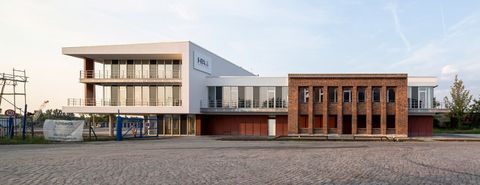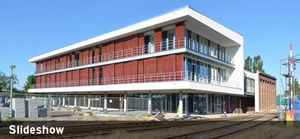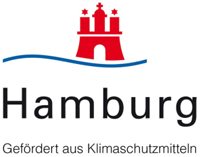Hamburg’s first office building constructed to a passive house standard
New Port Railway Building on Spreehafen Island


SIMILAR PROJECTS
Cities and Climate Change
 A memorial drives the district
A memorial drives the district
Energy Bunker
to the projectCities and Climate Change
 A virtual power station - in the network of synergies
A virtual power station - in the network of synergies
Integrated Energy Network Wilhelmsburg Central
to the project
New Port Railway Building on Spreehafen Island
Hamburg's first office building constructed to a passive house standard has been taking shape on an island in the Spreehafen, proving that energy-efficient construction is also possible for non-residential buildings.
This island, which is used exclusively for commercial sites, is accessible from near the customs station on Klütjenfelder Strasse. It is home to the premises of the port railway, which includes workshops, storage areas, and office buildings. Most of the existing buildings on Brandenburger Strasse have been demolished, with new developments taking their place. However, the brick façade of the old office building remains, and was integrated into the new build, which has been constructed to a passive house standard.
The building has a reinforced concrete frame and a thermal insulation system clad in light-coloured plaster. In addition to the entrance area, the ground floor of the building contains the installation rooms. Offices and common rooms can be found on the first floor, and conference rooms on the second floor. Three sides of the upper floors are designed so as to allow people to walk around the building.
Besides providing optimal insulation for the outer walls of the building, installing top-class windows, and drawing up detailed plans, the building's infiltration heat requirement needs to be reduced as a matter of urgency if the energy standard is to be met. The building is therefore being fitted with a controlled ventilation unit. Energy is supplied via geothermal power and a heat pump, among other methods, which are powered solely by solar power from an adjoining new factory building. The energy concept is further enhanced by a solar thermal energy unit for preparing hot water and a condensing gas boiler for peak load times. The heating and cooling systems are mainly operated by thermally activated concrete ceiling surfaces. Radiators are also used to better regulate heat in the office areas and in the sections of the building with suspended ceilings, such as the toilets.
The building's facilities are enhanced by the newly constructed factory building, which has a photovoltaic unit with a capacity of 175 on-peak kWh on the southern part of its roof.
The development lies on the newly created circular trail around the Spreehafen.

This project is supported by:
Free and Hanseatic City of Hamburg
Coordination Center for Climate Issues

ADDRESS
Brandenburger Straße 19
20457 Hamburg
SPECIFICATIONS
Size:
Gross floor area: 1.845 sqm
Gross cubature: 6.740 sqm
Investment costs:
ca. 3.3 Mio. Euro
Beginning of construction:
July 2012
Completion:
May 2013
Usage:
office and administration
Energy standard:
Passive-house standard
Energy supply:
Heat pump with the usage of geothermal power via activated foundation piles, production of energy from the adjoining factory building
INVESTOR
Hamburg Port Authority AöR (HPA)
Veddeler Damm 14
20457 Hamburg